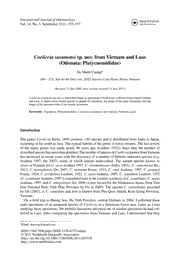
Coeliccia sasamotoisp. nov. from Vietnam and Laos (Odonata: Platycnemididae) PDF
Preview Coeliccia sasamotoisp. nov. from Vietnam and Laos (Odonata: Platycnemididae)
InternationalJournalofOdonatology Vol.14,No.3,September2011,193–197 Coeliccia sasamotoi sp. nov. fromVietnam and Laos (Odonata: Platycnemididae) DoManhCuong* 409–57A,TaptheBoThuysan,20/22NguyenCongHoan,Hanoi,Vietnam (Received13July2009;finalversionreceived14June2011) Coelicciasasamotoisp.nov.isdescribedbasedonspecimensofbothsexescollectedfromcentralVietnam andLaos.Itdiffersfromrelatedspeciesindetailsofcoloration,theshapeofthemaleterminalia,andthe shapeoftheposteriorlobeofthefemalepronotum. Keywords: Zygoptera;Platycnemididae;Coelicciasasamotoi;newspecies;Vietnam;Laos Introduction The genus Coeliccia Kirby, 1890 contains c.60 species and is distributed from India to Japan, occurringasfarsouthasJava.Thetypicalhabitatofthegenusisforeststreams.Thelastreview of the entire genus was made nearly 80 years ago (Laidlaw 1932); since then the number of describedspecieshasmorethandoubled.ThenumberofspeciesofCoelicciaknownfromVietnam hasincreasedinrecentyearswiththediscoveryofanumberofhithertounknownspecies(e.g. Asahina 1997, Do 2007), many of which remain undescribed. The named species known to occurinVietnamareC.accoAsahina1997,C.chromothorax(Selys,1891),C.cyanomelasRis, 1912, C. hoangliensis Do, 2007, C. montana Fraser, 1933, C. onoiAsahina, 1997, C. poungyi Fraser,1924,C.pyriformis Laidlaw,1932,C.satoiAsahina,1997,C.scutellum Laidlaw,1932 (C.tomukuniiAsahina,1997isconsideredheretobeajuniorsynonymofC.scutellum),C.ueoni Asahina,1997,andC.mingxiengisXu,2006(anewrecordfortheVietnamesefauna,fromTam Dao National Park,Vinh Phuc Province by Do in 2009). The species C. yamashakii, recorded byDo(2007),isC.scutellum andnowisknownfromPhuQuocIsland,KienGiangProvince, Vietnam. On a field trip to Huong Son, Ha Tinh Province, centralVietnam in 2004, I collected three male specimens of an unnamed species of Coeliccia in a limestone forest area. Later, as I was studyingthesespecimens,MrAkihikoSasamotoinformedmeofsimilarspecimenshehadcol- lected in Laos.After comparing the specimens fromVietnam and Laos, I determined that they *Email:[email protected] ISSN1388-7890print/ISSN2159-6719online ©2011WorldwideDragonflyAssociation http://dx.doi.org/10.1080/13887890.2011.607078 http://www.tandfonline.com 194 M.C.Do belongtothesamespecies,describedhereasC.sasamotoisp.nov.Terminologyforwingvena- tion used here follows that in Rehn (2003), which was derived from Riek and Kukalová-Peck (1984). Coelicciasasamotoisp.nov. (Figures1–2) Specimensexamined Holotype(cid:2)RaoMac,HuongSon,HaTinhProv.,CentralVietnam,3May2004,leg.M.C.Do. Paratypes:2(cid:2),dataasholotype;2(cid:2),1(cid:3),LakSao,BolikhamayProv.,KaewNeuaPassarea, centraleastLaos,11July2005,leg.A.Sasamoto;6(cid:2),4(cid:3),samelocalityandcollector,12July 2005.TheholotypewillbedepositedintheVietnamNationalMuseumofNature. Etymology Named for MrAkihiko Sasamoto, a Japanese odonatologist, who independently collected the paratypesfromLaosandwhopointedoutthattheyrepresentedanewspecies. Figure 1. Coelicciasasamotoisp.nov.♂:(a)head,obliqueview;(b)thorax,lateralview;(c)analappendages,lateral view;(d)analappendages,dorsalview;(e)analappendages,dview;(f)penis;(g)forewing;(h)hindwing. Coelicciasasamotoisp.nov. 195 Figure 2. Coelicciasasamotoisp.nov.♀:(a)head,obliqueview;(b)thorax,lateralview;(c)prothorax,obliqueview; (d)terminalabdominalsegmentsandovipositor,lateralview. Descriptionofholotypemale Head. Labium largely brownish white, end hooks of the labial palps shining black. Labrum, clypeusandfronsdeepblack,withbroadbluebandanteriorlyonfronsabovetheclypeus,nar- rowingcentrally(Figure1a).Mandiblebasesskybluewithblackmargin.Genaeskyblue.Vertex and postfrons matte black, with small bean-shape blue spot running from each lateral ocellus towards,butnotquitereaching,antenna,andapairofbluetransverselyorientedtear-dropshaped postocularspots(Figure1a). Thorax. Prothoraxblackwithlargelateralbluemarkingoccupyingmuchofpropleuronandparts ofanteriorandmiddlepronotallobes(Figure 1b),withirregularblackstripealongnotopleural suture.Synthoraxblackwithbluemarkings.Apairofmarkingsoneachsideofmesepisternum (Figure 1b); a small upper mark and much larger lower mark covering almost half the lower partofmesepisternum.Mesepimeronlargelyblack.Mesinfraepisternumblackexceptsmallarea above middle coxa. Metepimeron mostly occupied by large bluish marking of irregular shape (Figure 1b). Metepimeron largely bluish, meteinfraepisternum black above, pale below. Legs cream yellowish, with blackish extensor and flexor surfaces on femur and tibia; apices of tibia and tarsus wholly black; the tarsal claws dark, unequally bifid. Wings (Figure 1g–h) hyaline withbrownishpterostigmacovering11 −11 cells.RP3arisingslightlyproximaltosubnodusin 5 4 bothwings,IR2arisingatsubnodusinFw,slightlydistaltoitinHw.Discoidalcelltrapezoidal withbasalandcostaledgesshorterinbothwings.Fwwith20PxandHwwith19Px.RP2arising proximally at about 8th–9th postnodal cross vein from base of wing. IR1 arising proximally at 11th–12thpostnodalcrossveinfrombaseofwing.Threepostdiscoidalcellstolevelofsubnodus inbothforeandhindwings.Arculusataboutsecondantenodalcrossveinfrombaseofwing. Abdomen. Slender,blackwithyellowandbluishmarkings.S1withbroadpalebluespotlater- ally,taperingtowarddorsum.S2withventrolateralpalebluestripe,neitherendofwhichreaches correspondingintersegmentalzone.S3withbasalblueannulus,interrupteddorsally,andapico- lateral yellowish blue marking, gradually tapering forward. S4–S7 with apical spots similar to that of S3. S7–S9 wholly black. S10 black, gently depressed on the dorso-apical border, with faint apical dorsolateral dark yellow markings (Figure 1d–e). Sternites of S1–S6 dark yellow, becominggraduallyblackerapicallyonS7–S9. Anal appendages. Superior appendages goldenrod yellow, about 11 times length of S10. In 5 lateral view, thick and club shaped, slightly widening apically, with ventral subapical tooth at 196 M.C.Do c.2/3 of their length (Figure 1c). In dorsal view, broad and roughly oblong, widening apically, roundedattips,withinnermarginsinuous(Figure1d).Inferiorappendagesofsimilarcolourto superiorappendages,withsmallblacktoothatapex,oftypicalshapeforthegenusandslightly longerthanthesuperiors(Figure1c,e). Penis. (genital ligula; Figure 1f). 1st segment robust, without setae on sclerotized shaft; 2nd segmentexpandedlaterally;3rdsegmentfan-shaped,withpairofcentrallyplacedapicalflagella arisingfromacommonorigin. Measurements(mm). Hw27.5;abdomen(excl.appendages)45.0;superiorappendagesc.1.0 Female Asinmaleexceptgenerallymorerobustandasnotedbelow. Head. Sky-bluemarkingsofmalereplacedwithbluishyellow;markingsoriginatingfromlateral ocelli more extensive, forming irregular transverse stripe extending to compound eye margin (Figure2a). Thorax. Prothorax(Figure2b,c)mostlyyellowexceptforextensiveblackareaontheanterior lobe,narrowlyseparatedfromposteriorandcentralblackareaonmedianlobe,entireposterior lobe black. Posterior lobe consisting of broad raised median part with rounded top and pair of small dog-ear shaped lateral parts. Synthorax (Figure 2b) black with bluish-yellow markings. Overallmarkedsimilarlytomale,butlowermarkingonmesepisternumslender,halfaswideas mesepisternum;uppermarkalmostasinmale.Palemarkingonmetepisternummoreextensive thaninmale.Wingswithvenationsimilartomale.InFw17–19Px,and17–18PxinHw. Abdomen. Blackwithyellowmarkings;patternverysimilartomale,withbluemarkingsreplaced by yellow. Each marking a little broader than corresponding marking in male. S8 black with apical dark yellow lateral marking (Figure 2d), sternite of same colour. S9 black with uneven dark yellow spot dorsolaterally on each side in apical half. S10 and appendages mostly black. Ovipositor(Figure2d)blackwithyellowbasallyandapically,reachingalittlebeyondcerci. Measurements(mm). Hw25.3–25.8;abdomen(excl.ovipositor)41.0. Variationinmaleparatypes Thereislittlevariationamongmaleparatypesexceptsomewingvenationcharacteristics:Pxof forewing20–21,Pxofforewing18–19. Measurements(mm). Hw27–27.5;abdomen(excl.appendages)44.5–45.7;superiorappendages 1–1.1. Habitat Foundinpristineforestonlimestonemountainsatabout400–600m. Coelicciasasamotoisp.nov. 197 Diagnosisanddiscussion Males of C. sasamotoi bear a superficial resemblance to those of C. didyma because of the similar marking on the synthorax. However, the lower mesepisternal marking of C. sasamotoi is much broader than that of C. didyma, and the latter species has much more extensive pale markings on the terminal abdominal segments; moreover the two species are easily told apart by the structure of the anal appendages. The club-like (in lateral view) superior appendage of C.sasamotoiisdistinctiveandservestoseparatethemaleeasilyfrommostotherregionalspecies. Ofspecieswiththesuperiorappendageofsimilarshapeinlateralview,thatofC.hoangliensis ismuchshorter,thatofC.poungyihastheprominentventraltoothplacedataroundmid-length, and C. chromothorax and C. scutellum are easily separated from C. sasamotoi by their bright yelloworgreenish-yellow,undividedmesepisternalmarkingsandmoreextensivepalemarkings on S9–S10. The enigmatic C. pyriformis, known only from the type from Tonkin, is said to havesuperiorappendages“ratherclub-shaped”butwithouta“markedprojection”andwiththe inferiors“muchlonger”(Laidlaw1932),andalsodiffersinmanydetailsofcoloration.Theranges ofC.chromothoraxandC.scutellumoverlapthatofC.sasamotoi.Amongstregionalspeciesthe penisofC.sasamotoiappearstobemostsimilartothatofC.chromothoraxandC.hoangliensis, withtwolongterminalflagellaarisingfromacommonorigin;thepenisofC.scutellumapparently has never been figured. It is likely that C. chromothorax, C. hoangliensis, C. sasamotoi and C.scutellumarecloselyrelated. The female of C. sasamotoi differs from all other named species known fromVietnam and Laosinthestructureoftheposteriorpronotallobe,inhavingdividedmesepisternalmarkingsand otherdetailsofcoloration. Acknowledgements IamsincerelythankfultoMrAkihikoSasamoto,whonotonlykindlypassedmethespecimensfromLaostodothe description,butalsohashelpedmemanytimesformyresearchinVietnamesedragonflies.IalsothankRoryDowand MikeMaywhohelpedmeincompletingandrevisingthemanuscript. References Asahina,S.(1997).RecordsoftheNorthernVietnameseOdonatatakenbytheexpeditionmembersfromtheNationalSci- enceMuseum,Tokyo.5.Coenagrionidae,Protoneuridae,Platycnemididae.BulletinoftheNationalScienceMuseum, Tokyo(A)23(1),17–34. Do,M.C.(2007).Coelicciahoanglienensisspec.nov.,anewplatycnemiddamselflyfromHoangLienMountainsin thenorthofVietnam(Zygoptera:Plastinemididae[sic]).InB.K.Tyagi(Ed.)Odonata:BiologyofDragonflies(pp. 343–348).Jodhpur,Rajasthan,India:ScientificPublishers. Laidlaw,F.F.(1932).ArevisionofthegenusCoeliccia(OrderOdonata).RecordsoftheIndianMuseum,34,7–42,3pls. RehnC.A.(2003).Phylogeneticanalysisofhigher-levelrelationshipsofOdonata.SystematicEntomology,28,181–239. Riek,E.F.&Kukalova-Peck,J.(1984).AnewinterpretationofdragonflywingvenationbaseduponEarlyUpperCar- boniferousfossilsfromArgentina(Insecta:Odonatoidea)andbasiccharacterstatesinpterygotewings.Canadian JournalofZoology,62,1150–1166.
